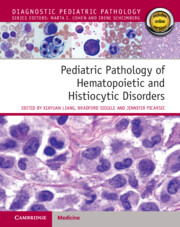Book contents
- Pediatric Pathology of Hematopoietic and Histiocytic Disorders
- Pediatric Pathology of Hematopoietic and Histiocytic Disorders
- Copyright page
- Epigraph
- Contents
- Contributors
- Section I General Hematology and Hematopathology
- Section II Non-Neoplastic Hematologic Disorders of Blood and Bone Marrow
- Section III Non-Neoplastic Disorders of Extramedullary Lymphoid Tissues
- Section IV Neoplastic Disorders of Bone Marrow
- Chapter 9 Ancillary Tests
- Chapter 10 Juvenile Myelomonocytic Leukemia (JMML)
- Chapter 11 Myeloid/Lymphoid Neoplasms with Eosinophilia and Gene Rearrangement
- Chapter 12 Myeloproliferative Neoplasms (MPNs)
- Chapter 13 Childhood Myelodysplastic Syndromes (MDSs)
- Chapter 14 Acute Myeloid Leukemia with Related Precursor Neoplasms
- Chapter 15 Myeloid Neoplasms with Germline Predisposition
- Chapter 16 Blastic Plasmacytoid Dendritic Cell Neoplasms (BPDCNs)
- Chapter 17 Acute Leukemia of Ambiguous Lineage
- Chapter 18 Precursor Lymphoid Neoplasms
- Chapter 19 Solid Tumor Metastasis to the Bone Marrow
- Section V Mature Lymphoid Neoplasms
- Section VI Histiocytic Disorders and Neoplasms
- Index
- References
Chapter 9 - Ancillary Tests
from Section IV - Neoplastic Disorders of Bone Marrow
Published online by Cambridge University Press: 25 January 2024
- Pediatric Pathology of Hematopoietic and Histiocytic Disorders
- Pediatric Pathology of Hematopoietic and Histiocytic Disorders
- Copyright page
- Epigraph
- Contents
- Contributors
- Section I General Hematology and Hematopathology
- Section II Non-Neoplastic Hematologic Disorders of Blood and Bone Marrow
- Section III Non-Neoplastic Disorders of Extramedullary Lymphoid Tissues
- Section IV Neoplastic Disorders of Bone Marrow
- Chapter 9 Ancillary Tests
- Chapter 10 Juvenile Myelomonocytic Leukemia (JMML)
- Chapter 11 Myeloid/Lymphoid Neoplasms with Eosinophilia and Gene Rearrangement
- Chapter 12 Myeloproliferative Neoplasms (MPNs)
- Chapter 13 Childhood Myelodysplastic Syndromes (MDSs)
- Chapter 14 Acute Myeloid Leukemia with Related Precursor Neoplasms
- Chapter 15 Myeloid Neoplasms with Germline Predisposition
- Chapter 16 Blastic Plasmacytoid Dendritic Cell Neoplasms (BPDCNs)
- Chapter 17 Acute Leukemia of Ambiguous Lineage
- Chapter 18 Precursor Lymphoid Neoplasms
- Chapter 19 Solid Tumor Metastasis to the Bone Marrow
- Section V Mature Lymphoid Neoplasms
- Section VI Histiocytic Disorders and Neoplasms
- Index
- References
Summary
Hematolymphoid malignancies represent an area in which ancillary studies offer particularly valuable information for diagnosis, classification, and prognosis, as well as risk-stratified and targeted therapy. The results of multiple test modalities, including flow cytometry, immunohistochemistry, and cytogenetic and molecular genetic analyses, should be integrated and interpreted within the context of morphologic evaluation. In this chapter, the principles, general technical aspects, and clinical applications of these ancillary tests are discussed.
- Type
- Chapter
- Information
- Publisher: Cambridge University PressPrint publication year: 2024



